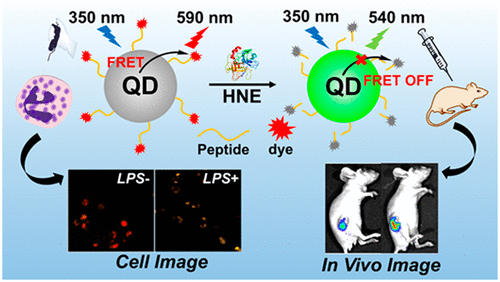Our official English website, www.x-mol.net, welcomes your
feedback! (Note: you will need to create a separate account there.)
Human Neutrophil Elastase Activated Fluorescent Probe for Pulmonary Diseases Based on Fluorescence Resonance Energy Transfer Using CdSe/ZnS Quantum Dots.
ACS Nano ( IF 15.8 ) Pub Date : 2020-03-25 , DOI: 10.1021/acsnano.9b09493 Shi-Yu Liu 1 , Ai-Min Yan 1 , Wu Ying-Zheng Guo 1 , Yuan-Yuan Fang 2 , Qing-Jian Dong 2 , Rong-Rong Li 1 , Sheng-Nan Ni 1 , Yao Sun 1 , Wen-Chao Yang 1 , Guang-Fu Yang 1, 3
ACS Nano ( IF 15.8 ) Pub Date : 2020-03-25 , DOI: 10.1021/acsnano.9b09493 Shi-Yu Liu 1 , Ai-Min Yan 1 , Wu Ying-Zheng Guo 1 , Yuan-Yuan Fang 2 , Qing-Jian Dong 2 , Rong-Rong Li 1 , Sheng-Nan Ni 1 , Yao Sun 1 , Wen-Chao Yang 1 , Guang-Fu Yang 1, 3
Affiliation

|
There is an increasing demand for effective noninvasive diagnosis against common pulmonary diseases, which are rising sharply due to the serious air pollution. Human neutrophil elastase (HNE), a typical protease highly involved in pulmonary inflammatory diseases and lung cancer, is a potential predictor for disease progression. Currently, few of the HNE-targeting probes are applicable in vivo due to the limitation in sensitivity and biocompatibility. Herein, we reported the achievement of in vitro detection and in vivo imaging of HNE by incorporating the HNE-specific peptide substrate, quantum dots (QDs), and organic dyes into the fluorescence resonance energy transfer (FRET) system. The refined nanoprobe, termed QDP, could specifically measure the HNE with excellent sensitivity of 7.15 pM in aqueous solution and successfully image the endogenous and exogenous HNE in living cells. In addition, this nanoprobe enabled HNE imaging in mouse models of lung cancer and acute lung injury, and the HNE activity at high temporal and spatial resolution was continuously monitored. Most importantly, QDP successfully discriminated the serums of patients with lung diseases from those of the healthy controls based on the HNE activity determination. Overall, this study demonstrates the advantages of a FRET-system-based nanoprobe in imaging performance and provides an applicable tool for in vivo HNE detection and pulmonary disease diagnosis.
中文翻译:

基于使用CdSe / ZnS量子点的荧光共振能量转移的人类嗜中性粒细胞弹性蛋白酶激活的荧光探针,用于肺部疾病。
对常见的肺部疾病进行有效的非侵入性诊断的需求不断增长,由于严重的空气污染,这种疾病正在急剧上升。人嗜中性粒细胞弹性蛋白酶(HNE)是一种高度参与肺炎性疾病和肺癌的典型蛋白酶,是疾病进展的潜在预测因子。目前,由于敏感性和生物相容性的限制,很少有HNE靶向探针可用于体内。本文中,我们报道了通过将HNE特异性肽底物,量子点(QDs)和有机染料掺入荧光共振能量转移(FRET)系统中,实现了HNE的体外检测和体内成像。经过改进的纳米探针QDP可以特异性地测量HNE,灵敏度高达7。水溶液中浓度为15 pM,可以成功成像活细胞中的内源性和外源性HNE。此外,这种纳米探针可以在肺癌和急性肺损伤的小鼠模型中进行HNE成像,并且可以持续监测高时空分辨率下的HNE活性。最重要的是,基于HNE活性测定,QDP成功地将肺部疾病患者的血清与健康对照组的血清进行了区分。总体而言,这项研究证明了基于FRET系统的纳米探针在成像性能方面的优势,并为体内HNE检测和肺部疾病诊断提供了适用的工具。并持续监测高时空分辨率下的HNE活动。最重要的是,基于HNE活性测定,QDP成功地将肺部疾病患者的血清与健康对照组的血清进行了区分。总体而言,这项研究证明了基于FRET系统的纳米探针在成像性能方面的优势,并为体内HNE检测和肺部疾病诊断提供了适用的工具。并持续监测高时空分辨率下的HNE活动。最重要的是,基于HNE活性测定,QDP成功地将肺部疾病患者的血清与健康对照组的血清进行了区分。总体而言,这项研究证明了基于FRET系统的纳米探针在成像性能方面的优势,并为体内HNE检测和肺部疾病诊断提供了适用的工具。
更新日期:2020-03-25
中文翻译:

基于使用CdSe / ZnS量子点的荧光共振能量转移的人类嗜中性粒细胞弹性蛋白酶激活的荧光探针,用于肺部疾病。
对常见的肺部疾病进行有效的非侵入性诊断的需求不断增长,由于严重的空气污染,这种疾病正在急剧上升。人嗜中性粒细胞弹性蛋白酶(HNE)是一种高度参与肺炎性疾病和肺癌的典型蛋白酶,是疾病进展的潜在预测因子。目前,由于敏感性和生物相容性的限制,很少有HNE靶向探针可用于体内。本文中,我们报道了通过将HNE特异性肽底物,量子点(QDs)和有机染料掺入荧光共振能量转移(FRET)系统中,实现了HNE的体外检测和体内成像。经过改进的纳米探针QDP可以特异性地测量HNE,灵敏度高达7。水溶液中浓度为15 pM,可以成功成像活细胞中的内源性和外源性HNE。此外,这种纳米探针可以在肺癌和急性肺损伤的小鼠模型中进行HNE成像,并且可以持续监测高时空分辨率下的HNE活性。最重要的是,基于HNE活性测定,QDP成功地将肺部疾病患者的血清与健康对照组的血清进行了区分。总体而言,这项研究证明了基于FRET系统的纳米探针在成像性能方面的优势,并为体内HNE检测和肺部疾病诊断提供了适用的工具。并持续监测高时空分辨率下的HNE活动。最重要的是,基于HNE活性测定,QDP成功地将肺部疾病患者的血清与健康对照组的血清进行了区分。总体而言,这项研究证明了基于FRET系统的纳米探针在成像性能方面的优势,并为体内HNE检测和肺部疾病诊断提供了适用的工具。并持续监测高时空分辨率下的HNE活动。最重要的是,基于HNE活性测定,QDP成功地将肺部疾病患者的血清与健康对照组的血清进行了区分。总体而言,这项研究证明了基于FRET系统的纳米探针在成像性能方面的优势,并为体内HNE检测和肺部疾病诊断提供了适用的工具。











































 京公网安备 11010802027423号
京公网安备 11010802027423号